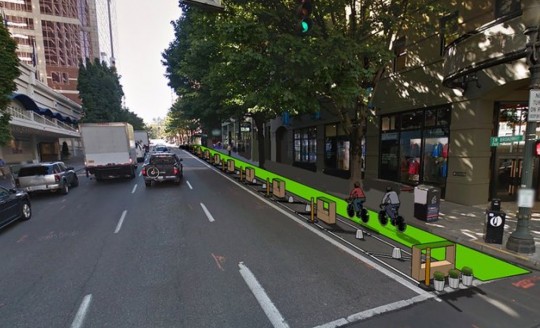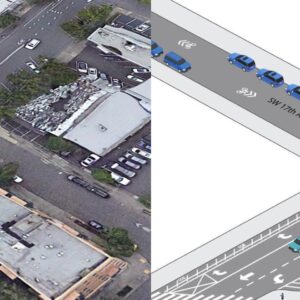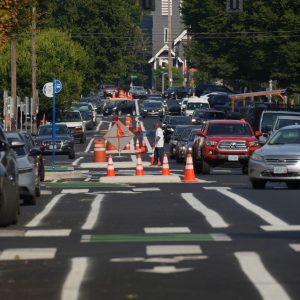
(Image: Nick Falbo/Alta Planning + Design)
Tactical urbanism is about to make another imprint on Portland’s downtown streetscape. Tomorrow morning, a trio of planning and place-making groups are planning to create a temporary protected bike lane on one block of Southwest Broadway.
As you can see in the photo above the plan is to install temporary green coloration and objects in a buffer zone to provide protection of a curbside bike lane. The bike lane will stretch one block of Broadway from Salmon to Taylor. And yes, it will use road space currently used to park people’s personal vehicles. The permitted project is a collaboration between Better Block PDX (the folks who brought us similar projects on SW 3rd and Naito), Place Matters from Denver, and Portland-based Alta Planning + Design.
Tomorrow’s installation is timed to coincide with the New Partners for Smart Growth conference, which kicks off tomorrow at the Hilton which happens to be right across the street.
Advertisement
It’s worth noting that this temporary installation is mere blocks from what we used to call Portland’s first “cycle track”, installed as part of a promise made by former Portland Mayor Sam Adams in 2009. The idea from city engineers and planners at the time was that this higher-quality and buffered bike lane would ultimately extend to Burnside, then up to the Broadway Bridge and beyond. However, that was when we had a mayor who wasn’t afraid to be bold when it came to cycling. Now six-and-a-half years later, the protected bikeway on Broadway near Portland State hasn’t been extended or improved upon at all.
Thankfully we’ve got these upstart urbanist to remind us of what we should be doing. A protected bike lane on Broadway — arguably the most important street in our city — should have a starring role and not just a one-day cameo.
— Jonathan Maus, (503) 706-8804 – jonathan@bikeportland.org
BikePortland can’t survive without paid subscribers. Please sign up today.





Thanks for reading.
BikePortland has served this community with independent community journalism since 2005. We rely on subscriptions from readers like you to survive. Your financial support is vital in keeping this valuable resource alive and well.
Please subscribe today to strengthen and expand our work.
about time
Yes. When? What hours?
One block for one day. wooo freakin’ hooo.
This is fantastic news, I’m so excited this is happening. Go Better Block PDX Go!
This could, and should, ABSOLUTELY become a permanent reality. There really isn’t the auto-traffic demand to keep Broadway as a car sewer. We really ought to have it as one of the solidly built, protected corridors with physical seperation!
Brilliant. I look forward to riding in this! Could this be a hint of things to come?
This is great news, however, rather than removing parking I think SW Broadway should go on a road diet and lose one auto lane.
I would far rather convert the Park blocks to bike greenways, using diverters and parking removal. Diverters would prevent drivers from using Park St as a through street. Parking removal would further reduce traffic.
Compared to Broadway, the Park Blocks are a more pleasant place to ride, have very little auto through traffic demand (most cars on Park St are looking for parking), few or no businesses that are incompatible with a barriered curbside cyclepath, and on a Park Blocks greenway you wouldn’t even need a barrier.
Finally, a permanent barriered cyclepath on Broadway is very unlikely to happen. It will be blocked by the opposition of businesses, and Broadway has a high density of major businesses and commercial buildings. Notice that this demonstration project is only 1 block and avoids any blocks with hotels or major retailers.
This is precisely why Broadway should get protected bike lanes. Don’t people arriving by bicycle deserve access to businesses too? People demand car parking right in front of their business, but when it comes to people cycling, they get hidden away on side routes or greenways. This need to change.
Well, Columbia Sportswear is a pretty major retailer. There is also a bank and an excellent local menswear shop on that block. As far as pleasantness goes, yes the tree canopy, gardens, etc on the park blocks are very pleasant but having to cross streets like Washington without a signal is not. Pleasantness is also quite subjective. Many people who chose to live in cities enjoy the social aspect of being around other people, making eye contact and being part of the bustle of the more vibrant parts of the city. We should make room for both.
The issue with making the Park Blocks a bikeway is not motor vehicle traffic on the Park Blocks. The problem is that there are stop signs *every* 250-ft. That’s very inconvenient, and, more importantly, nerve-racking, especially where one has to cross two to three lanes of heavy traffic. I don’t even like walking along the Park Blocks for this reason.
Not sure how the three blocks of road work just past this spot on SW Broadway will impact the plan. As I can see it right now from my office window, there are traffic cones for a water/sewer project blocking the bike lane and the right two lanes of Broadway from Main to Jefferson.
This is a very small demonstration project put on in conjunction with the hotel across the street. The demo is only one block long.
Despite it’s small scale, there will be a few new treatments used in the demo which will help us expand out toolkit for rapid deployment of projects like these.
Thanks Nick. I will defintely check it out.
On a related note, the work crews and cones further up Broadway departed about mid-afternoon Wednesday. There are a few steel plates in the car lanes that indicate they will be back, but not sure when.
These few blocks can be really scary during morning rush hour. It’s like playing frogger with delivery trucks in the bike lane, hotel valets and car service, pedestrians crossing against the signal, and vehicles turning right.
I think that the great majority of cyclists on Broadway are traveling through. That’s what I’ve always observed. Those who have destinations on Broadway are not going to be inconvenienced by riding one block over on Park then turning down to Broadway. Wherever you put a bike route, most people are not going to be going to destinations right on that street.
Riding on a properly-done Park greenway will be not only more pleasant than riding hemmed into a Broadway cyclepath, it will be safer: no conflicts with auto traffic turning on/off Broadway, no complicated multi-phase signals, no contention with the masses of pedestrians crossing Broadway.
Perhaps some people prefer to cycle amid the “bustle” of a busy street like Broadway. I suggest more people prefer to cycle away from heavy traffic and darting pedestrians, by pleasant greenery and public space.
Yes, a Park blocks greenway would need four way stops or signalized crossings at a couple of major streets.
Note also that the Park blocks allows a bi-directional cycle route. Go through the immense effort and lengthy fight of getting a barriered cyclepath on Broadway, even in the unlikely event you succeed, then you only have a southbound route. So where is your northbound route?. Good luck getting a barriered cyclepath on 6th St. Use Park as the northbound route? – then why not as the southbound route too?
The only way I can see a two-way cycleway working on the Park Blocks is if all four of the parking lanes are completely removed and bollards placed at every intersection to prevent drivers from entering the cycleway. Essentially close SW Park and 9th Avenues entirely to motor vehicle access. Otherwise, you still end up wth too many conflicts between drivers and people cycling.
I assume by “9th” you mean Park St southbound, that runs to the west of the Park Blocks.
I think parking removal on at least one side of the street – and maybe both – would be necessary, because the roads (Park St northbound and Park St southbound) are otherwise not wide enough.
Entirely closing both streets to vehicles might be tough. There are businesses that need deliveries, and a couple of parking garages that open to those streets.
But diverters on the cross streets (like the one on Ankeney at 20th) could prevent drivers from using either Park St as a through route. And removing parking – and making any remaining parking just 30 minutes and/or very expensive – could remove the reason for drivers to circle on these streets to find a parking space.
If the vehicle traffic on the two Park Streets were just vehicles making deliveries, dropping visitors at the Museum, and going in and out of a few parking garages, there would be very little vehicle traffic – certainly quiet enough for a greenway. Use other calming like bumpouts, speed bumps, signage, and it would be a very peaceful place to ride.
Another option would be to modify only one of the Park Streets, but really go “all the way”. Make it two way for bikes, eliminate all street parking and make all curbs for drop off/pick up only (no waiting or parking), install diverters and calming as described above. If possible, close it entirely to vehicles (other than emergency and delivery, perhaps). I’m not sure which of the two Park Streets would be better for this treatment – maybe the eastern one (that is currently northbound).
It might be nice to have some street seating areas in spots, kind of like Ankeney Alley. With the entire roadway to work with, there could be enough room. And this might help any restaurants who are hurt by parking removal.
I think the Park Blocks represent a big opportunity and unfulfilled promise. Simply because they are there, Park St hasn’t been developed that intensively. We have a chance to really make a bike facility of it, because it is already partway there. Trying to make Broadway into the mythical “8-80” route is pretty much impossible, in my view.
9th Av continues north from the Park Blocks, but yes, that is essentially what I meant. A cycleway on the Park Blocks would have to extend further to be useful, as a cycleway on Broadway would.
Yes, there will certainly be challenges in removing car access, but if we are looking at the Park Blocks as easier than Broadway, then we should go all the way. If you keep parking only on one side, then you lose a good six feet to the door zone and this would degrade the cycling experience considerably. Same goes for allowing freight access. Drivers would also be frequently stopping and backing up into the parking spaces, creating additional conflicts.
The Park Blocks are intended to be an escape from the city and a place to relax and recreate. Cars are incompatible wth this use. Car drivers have access to every street and every corner of our city center, it’s time we take some of that space back.
I agree.
The Park Blocks could be an amazing public space, stretching fully across downtown, lively with street seating, food and drink, markets, music and activity, grass and lounging, pedestrians, cyclists, and no or very few cars driving very slowly. Right now it is nice in many spots, but other parts are under used, and a few spots are becoming the domain of, umm, unattractive uses.
Perhaps one side of the Park Blocks could be fully dedicated to bike access, with the other side still allowing access to people and goods that need to arrive by car – vendors and less-mobile members of the public come to mind.
Is this feasible?. I am quite familiar with a part of the Park Blocks, less so with others. Maybe the full treatment couldn’t extend for the entirety of the stretch, but perfect need not be the enemy of good.
Businesses on Park St/9th have a legitimate interest here, and I think a lively, popular Park Blocks would be generally positive for many of them.
Drivers have a legitimate interest too, but few drivers really use Park St to get from point A to point B, since Broadway and 10th are so much better thoroughfares.
The Park Blocks were originally designed as a pedestrian/bicycle thoroughfare. The ONLY crossing by major streets (Gleason, Everett, and Burnside, in the northern part ) would need 4 way stops. The rest should be automatic crosswalk lights with stop signs for the East-West traffic.
By the way. this would coincide with what a portion of San Antonio is doing in the vicinity of “The Alamo”. The state of Texas is not noted for being a friendly place to cyclists but they are beginning to try.
Use four way stops? New signals would be ideal, but expensive.